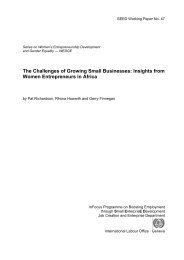manual: women workers' rights and gender equality - International ...
manual: women workers' rights and gender equality - International ...
manual: women workers' rights and gender equality - International ...
You also want an ePaper? Increase the reach of your titles
YUMPU automatically turns print PDFs into web optimized ePapers that Google loves.
Chapter 3<br />
Gender Equality<br />
Introduction<br />
This part contains four major subjects: self-awareness, values <strong>and</strong> attitudes, division of work <strong>and</strong><br />
access <strong>and</strong> control over resources. The four subjects together form a more or less complete<br />
package about the concept of <strong>equality</strong> between men <strong>and</strong> <strong>women</strong>. A brief explanation about the<br />
four subjects follows below.<br />
Self-Awareness<br />
A first step in training on <strong>gender</strong> <strong>equality</strong> is creating self-awareness. Without talking about <strong>gender</strong>,<br />
people should learn to think about their lives <strong>and</strong> the routines in their lives. The exercises form a<br />
start for discussions about changing things in life. Choose only one exercise.<br />
Values <strong>and</strong> Attitudes<br />
The second step deals with existing values <strong>and</strong> attitudes. The exercises given under this subject<br />
explain the difference between sex <strong>and</strong> <strong>gender</strong> <strong>and</strong> elaborate about <strong>gender</strong> roles. During the<br />
discussions the main focus is on changing existing <strong>gender</strong> roles, attitudes <strong>and</strong> social values.<br />
Choose only one exercise<br />
Division of Work<br />
Regarding the division of work three main steps have to be made. The first exercise deals with the<br />
difference in activities done by men <strong>and</strong> <strong>women</strong>. The next exercise focuses on the values attached<br />
to the work done by men <strong>and</strong> <strong>women</strong>. Finally, possible changes to the existing division of work are<br />
discussed. Do all three exercises to get a good underst<strong>and</strong>ing of the division of work between men<br />
<strong>and</strong> <strong>women</strong> <strong>and</strong> a fair distribution of workload between them.<br />
Access to <strong>and</strong> Control over Resources<br />
The next step is to identify the availability of resources to both men <strong>and</strong> <strong>women</strong> <strong>and</strong> to discuss<br />
<strong>equality</strong> in the decision making process regarding these resources.<br />
The main content of the <strong>manual</strong> is on advancing the position of <strong>women</strong> workers, as they are<br />
usually the ones who face inequalities <strong>and</strong> discrimination. The training content <strong>and</strong> process,<br />
however, are intended for mixed groups. Gender <strong>equality</strong> is a matter of both sexes <strong>and</strong> the only<br />
way to change the existing structure is by involving both men <strong>and</strong> <strong>women</strong> in the discussions.<br />
However, if there are large <strong>gender</strong> inequalities <strong>and</strong> a strict division of labour <strong>and</strong> decision-making<br />
between men <strong>and</strong> <strong>women</strong> among the target population <strong>and</strong> if <strong>women</strong> lack confidence, it is<br />
recommended to have training first in <strong>women</strong>-only groups.<br />
The role of the facilitator is to create solidarity among the <strong>women</strong> <strong>and</strong> to build up confidence<br />
among them. Being a member of a group makes <strong>women</strong> strong. Group members can support each<br />
other. At a later stage the facilitator can ask the group members in such <strong>women</strong>-only groups<br />
whether they like to invite their husb<strong>and</strong> <strong>and</strong>/or other male family members to the sessions about<br />
<strong>gender</strong> <strong>equality</strong>, because things can only change when both <strong>women</strong> <strong>and</strong> men are committed to do<br />
so. The members can then choose whether they like to have mixed group discussions or want to<br />
have discussions within their families by themselves.<br />
16

















